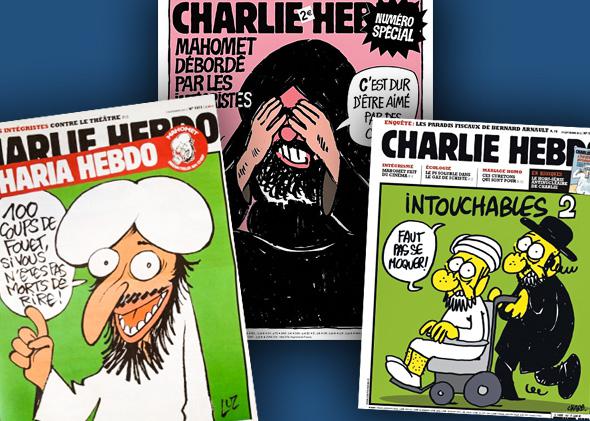On Wednesday, masked gunmen attacked the offices of the French satirical magazine Charlie Hebdo killing at least 12 people. While both the motive and the identity of the perpetrators are still unknown, the magazine is famous for its controversial cartoon covers. (Today’s cover features novelist Michel Houellebecq smoking a cigarette with the caption “In 2022, I will do Ramadan.” His latest novel, Submission, is said to be about a future France run by Muslims.) While they’ve mocked everything from Sept. 11 to Michael Jackson, Charlie Hebdo has riled up the most controversy when covering religion, particularly the Prophet Mohammed—who many Muslims believe it is forbidden to depict.
In 2006, the magazine featured Mohammed weeping with the headline “Mohammed Overwhelmed by Fundamentalism.” This was the cover of the issue that also featured reprinted cartoons from the Danish newspaper Jyllands-Posten that caricatured the prophet. Jacques Chirac, French president at the time, denounced the magazine and Muslim groups sued, but courts eventually ruled in Charlie Hebdo’s favor.
Perhaps the issue of the magazine that inspired the largest international reaction was published in 2012, and sports a cover depicting an orthodox Jewish man pushing a Muslim man in a wheelchair. The headline reads “Intouchables 2,” a spoof of the movie The Intouchables—at the time, France’s second biggest box-office hit—in which a rich white man who is paralyzed from the neck down hires a black ex-con from the projects to be his caretaker. But, as with the 2006 cover, the deeper controversy came on the next page with a satire of another movie, this time Innocence of Muslims, in which an ex-con paid people to act out scenes that had nothing to do with Islam before replacing the audio to create a terrible movie ridiculing the Prophet Mohammed. No one saw the movie at the time, but he posted a 14-minute video on YouTube and an anti-Muslim activist in Virginia translated it into Arabic and sent the link to activists in Egypt resulting in violent protests. The Charlie Hebdo cartoon depicts the prophet naked and in pornographic poses, and the French government urged the magazine not to publish the images. When the magazine refused, the French government closed embassies and consulates in about 20 countries as a precaution. (The movie and the cartoons also became the center of renewed conversations about free speech.)
The previous year, Mohammed graced the cover to celebrate the Tunisian Islamist party Ennahda’s victory in the recent elections. As a response, Charlie Hebdo printed a special issue called Charia Hebdo (pronounced like Sharia law, or Islamic law) “guest edited” by the prophet himself. The cover promised “100 lashes if you don’t die of laughter!” Charlie Hebdo’s homepage was subsequently hacked and replaced with the single phrase “No god but Allah.” The office was attacked with a Molotov cocktail that destroyed all the property and equipment inside. (Following that, the magazine published a Muslim man kissing a cartoonist.)
Not all the controversies have centered around depictions of men. In 2010, Charlie Hebdo supported France’s controversial law banning women from wearing burqas in public with the headline “Yes to wearing the burqa … on the inside!”—the intended meaning of which is pretty self-explanatory from the image.
The paper has also mocked the pope on multiple occasions, but perhaps most famous is the 2010 image of Pope Benedict XVI holding a condom above his head saying “This is my body” (a line from the liturgy of the Eucharist that, according to the New Testament, was uttered by Jesus at the Last Supper). This was in response to an excerpt from the book-length interview Light of the World in which the pope says some confusing things about when it is OK to wear a condom. Many considered it to be a reversal for the church to allow condom use to prevent the spread of HIV. The pope said contraception can be “a first step in a movement toward a different way, a more human way, of living sexuality.”
